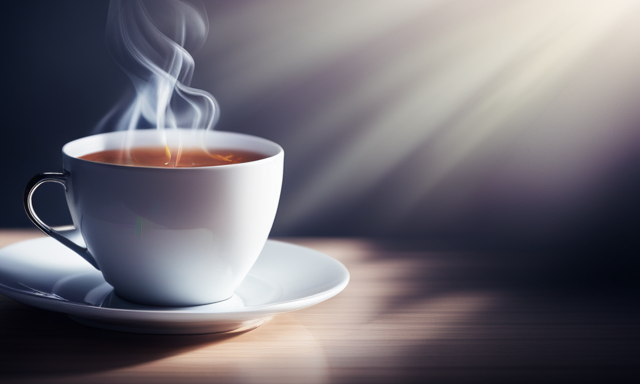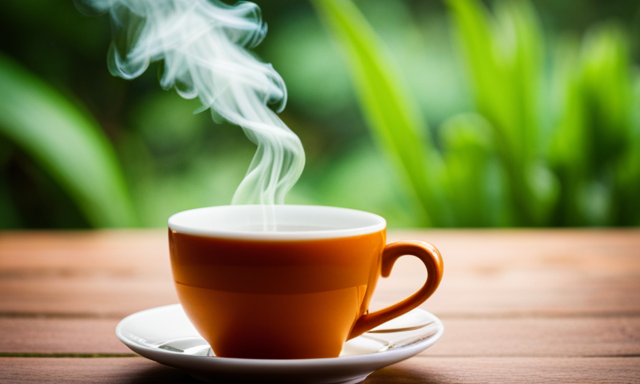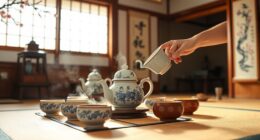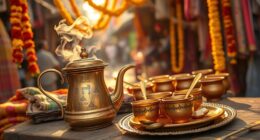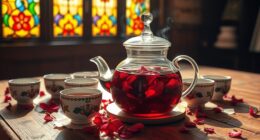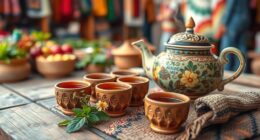Hey there! So, you’re curious about caffeine content in oolong tea, huh? Well, you’ve come to the right place. As someone who loves a good cup of oolong tea, I understand the importance of knowing exactly what I’m putting into my body. In this article, we’re going to dive deep into the world of oolong tea and explore just how much caffeine it contains.
Now, I know what you might be thinking – why is caffeine content such a big deal? Well, caffeine has its benefits, like providing a much-needed energy boost and improving focus. However, it’s also important to understand the potential effects of consuming too much caffeine. That’s why we’ll be discussing the different factors that can affect the caffeine content in oolong tea, as well as ways to reduce your caffeine intake if needed.
So grab yourself a cup of oolong tea, sit back, and get ready to become a caffeine connoisseur. Let’s get started!
Key Takeaways
- Oolong tea generally has lower caffeine levels compared to black tea, ranging from 30-50 milligrams per cup.
- Factors such as brewing time and temperature can affect the caffeine content in oolong tea.
- Oolong tea is a moderate source of caffeine, falling between green tea (lower caffeine) and black tea (higher caffeine).
- To reduce caffeine intake in oolong tea, steep it for a shorter duration, or explore caffeine-free alternatives like herbal teas.
Understanding Caffeine Content in Oolong Tea
Do you want to know how much caffeine is in a cup of oolong tea? Well, let’s dive into the world of tea and explore the caffeine content in different varieties.
Oolong tea is known for its unique taste and health benefits, but how much caffeine does it actually contain? Compared to black tea, oolong tea generally has lower caffeine levels. While black tea typically contains around 40-70 milligrams of caffeine per cup, oolong tea usually ranges from 30-50 milligrams.
However, it’s important to note that the caffeine content can vary depending on factors such as brewing time and temperature. So, if you’re looking for a tea with a moderate amount of caffeine, oolong tea might be a good choice.
Now, let’s move on to comparing caffeine levels in different teas.
Comparing Caffeine Levels in Different Teas
One interesting fact is that the caffeine levels in different types of tea can vary significantly. When comparing caffeine levels in herbal teas, it is important to note that they generally contain little to no caffeine. This is because herbal teas are made from various plants, flowers, and herbs that do not naturally contain caffeine. On the other hand, teas like black tea, green tea, and oolong tea are all derived from the same plant, Camellia sinensis, and can vary in caffeine content based on factors such as processing and brewing time. For example, black tea tends to have the highest caffeine content, followed by oolong tea and green tea. The impact of processing on caffeine levels in tea is quite significant, as different processing techniques can affect how much caffeine is retained in the final product. In the subsequent section, we will explore the factors that can affect the caffeine content in oolong tea.
Factors Affecting Caffeine Content in Oolong Tea
The caffeine content in oolong tea can be influenced by various factors. These factors include the specific cultivar of the tea plant, the altitude at which it is grown, and the duration of fermentation. Understanding these factors is crucial in determining the caffeine levels in oolong tea.
-
Cultivar: Different cultivars of the tea plant may have varying caffeine content. Some cultivars naturally produce more caffeine than others.
-
Altitude: Oolong tea grown at higher altitudes tends to have higher caffeine levels. This is because the tea plants at higher altitudes receive more sunlight, which stimulates caffeine production.
-
Fermentation: The duration of fermentation also affects caffeine content. Longer fermentation can result in a decrease in caffeine levels.
By considering these factors, we can better comprehend the caffeine content in oolong tea and its potential effects.
Transitioning into the subsequent section, it is important to explore the benefits and effects of caffeine in oolong tea.
The Benefits and Effects of Caffeine in Oolong Tea
Indulging in a steaming cup of oolong tea can provide a range of invigorating benefits and effects thanks to its caffeine content.
Caffeine, a natural stimulant, has been found to improve alertness, concentration, and cognitive performance. Its effects can vary depending on an individual’s caffeine metabolism, which determines how quickly the body processes and eliminates caffeine.
Some people may experience a boost in energy and enhanced mood, while others may be more sensitive to its effects and experience jitters or difficulty sleeping.
Additionally, regular consumption of oolong tea can lead to caffeine dependence and subsequent withdrawal symptoms when intake is reduced or discontinued.
Understanding the benefits and effects of caffeine in oolong tea sets the stage for exploring how its caffeine content differs from that of coffee.
How Caffeine in Oolong Tea Differs from Coffee
Comparatively, oolong tea contains approximately half the amount of caffeine found in a typical cup of coffee. When comparing the caffeine content in oolong tea to other types of tea, such as green tea and black tea, oolong tea falls somewhere in the middle.
Green tea generally has lower caffeine content than oolong tea, while black tea tends to have a higher caffeine content. This makes oolong tea a suitable choice for those looking for a moderate caffeine boost without the intensity of coffee.
However, it is important to note that the actual caffeine content can vary depending on factors such as the specific tea leaves used and the brewing process.
In the upcoming section, we will explore whether the steeping time affects the caffeine content in oolong tea, offering further insights into this fascinating topic.
Does the Steeping Time Affect Caffeine Content in Oolong Tea?
Want to know if steeping time affects the caffeine content in your oolong tea? Well, it turns out that it does. The amount of caffeine in your cup of oolong tea can vary depending on how long you steep it. When you steep oolong tea for a shorter period of time, the caffeine content is lower compared to steeping it for a longer period.
To help you understand this better, let’s take a look at the table below:
| Steeping Time (minutes) | Caffeine Content (mg) |
|---|---|
| 1 | 18 |
| 3 | 27 |
| 5 | 34 |
As you can see, the longer you steep your oolong tea, the more caffeine it will contain. This is because caffeine is released during the steeping process, and the longer the steeping time, the more time there is for the caffeine to be extracted from the tea leaves.
Now that we know how steeping time affects caffeine absorption, let’s move on to some tips for reducing caffeine intake in oolong tea.
Tips for Reducing Caffeine Intake in Oolong Tea
To cut back on your caffeine intake while enjoying oolong tea, try steeping it for a shorter duration, similar to how a gentle breeze can soften the intensity. This technique can help reduce the caffeine content in your cup of oolong tea.
The longer the tea leaves are steeped, the more caffeine is extracted. By steeping for a shorter time, you can still enjoy the rich flavors of oolong tea while minimizing your caffeine intake.
Reducing caffeine intake is important for those who are sensitive to caffeine or want to limit their overall consumption. Another option is to explore caffeine-free alternatives to oolong tea.
Herbal teas, such as chamomile or peppermint, offer a soothing and flavorful experience without the stimulating effects of caffeine. These alternatives can be a great way to enjoy a hot beverage without worrying about your caffeine intake.
Exploring Caffeine-Free Alternatives to Oolong Tea
One option for those seeking a caffeine-free alternative to oolong tea is to explore the world of herbal infusions, which offer a variety of soothing and flavorful choices.
When it comes to caffeine substitutes, herbal teas are a great option. These teas are made by infusing various herbs, flowers, and spices in hot water, resulting in a delicious and caffeine-free beverage.
Some popular herbal tea alternatives to oolong include chamomile, peppermint, and rooibos. Chamomile tea is known for its calming properties and can help with sleep and relaxation. Peppermint tea is refreshing and can aid digestion. Rooibos tea is rich in antioxidants and has a naturally sweet flavor.
These herbal teas provide a caffeine-free option for those looking to reduce their caffeine intake without compromising on taste.
As we delve into the next section about caffeine and health, it’s important to understand the different alternatives available.
Caffeine and Health: What You Need to Know
Consuming caffeine can have both positive and negative effects on our health, so it’s essential to be aware of the potential impacts.
When it comes to caffeine consumption, it’s important to consider our individual caffeine metabolism. Some people are fast metabolizers, meaning they can quickly break down and eliminate caffeine from their bodies. Others are slow metabolizers, and caffeine can stay in their system for a longer time, potentially leading to negative effects like sleep disturbances or increased anxiety.
Additionally, excessive caffeine intake has been associated with adverse health effects such as increased heart rate, high blood pressure, and digestive issues. It’s crucial to find the right balance in our caffeine consumption to avoid these potential health risks.
Transitioning into the subsequent section about enjoying oolong tea, finding the right balance is key to fully appreciating its benefits.
Enjoying Oolong Tea: Finding the Right Balance
When it comes to enjoying oolong tea, finding the right balance is key. Not only does this involve understanding the different flavor profiles of oolong tea, but it also means finding the perfect brewing temperature. Oolong tea can have a wide range of flavors, from floral and fruity to toasty and nutty. By experimenting with different brewing temperatures, you can bring out the best flavors in your cup of oolong tea. A higher temperature can enhance the floral and fruity notes, while a lower temperature can emphasize the toasty and nutty characteristics. To help you visualize the different flavor profiles and brewing temperatures of oolong tea, I’ve created a table below:
| Flavor Profile | Brewing Temperature |
|---|---|
| Floral and Fruity | 185°F – 195°F |
| Toasty and Nutty | 175°F – 185°F |
By understanding the different flavor profiles and experimenting with brewing temperatures, you can truly enjoy the unique and varied taste of oolong tea.
Frequently Asked Questions
How does the caffeine content in oolong tea compare to other types of tea?
Caffeine content varies among tea types. Oolong tea typically contains around 37-55 mg of caffeine per cup, which is less than black tea but more than green tea. Caffeine-free alternatives include herbal teas like chamomile or rooibos.
Can the caffeine content in oolong tea vary depending on the brand or quality of the tea?
The caffeine content in oolong tea can vary depending on the brand and quality. Different processing methods and tea leaves used may result in varying caffeine levels.
Are there any negative side effects of consuming too much caffeine in oolong tea?
Excessive caffeine in oolong tea can lead to a plethora of negative effects. From jitters to insomnia, it’s important to consider caffeine sensitivity before consuming. Moderation is key to avoid these potential drawbacks.
Can oolong tea be consumed by individuals who are sensitive to caffeine?
Individuals with caffeine sensitivity may want to consider alternatives to oolong tea. While it has less caffeine than other teas, it still contains a moderate amount. Opting for caffeine-free herbal teas or decaffeinated oolong tea can be a better choice.
Are there any specific health conditions or medications that may interact negatively with the caffeine in oolong tea?
As a scientist, I must warn that caffeine in oolong tea can interact negatively with certain health conditions or medications. It’s important to consider potential interactions, especially for those with caffeine sensitivity and oolong tea.
Conclusion
When it comes to oolong tea, many people wonder about its caffeine content. How much caffeine is actually in a cup of oolong tea? Well, the answer can vary depending on various factors such as the type of oolong tea, the brewing method, and the steeping time. On average, a cup of oolong tea contains about 30-50 milligrams of caffeine. This is significantly less than a cup of coffee, which typically contains around 95 milligrams of caffeine. However, it is important to note that caffeine content can vary, and some oolong teas may have higher or lower levels of caffeine. So, if you’re looking for a tea that provides a gentle energy boost without the jitters, oolong tea might just be the perfect choice for you.

